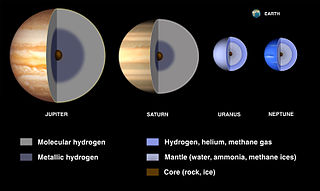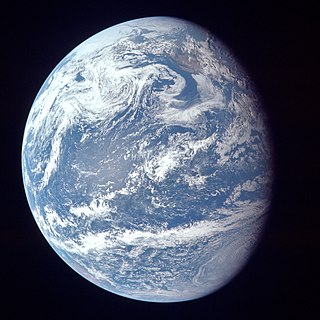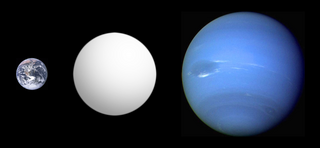Related Research Articles

An exoplanet or extrasolar planet is a planet outside the Solar System. The first possible evidence of an exoplanet was noted in 1917 but was not then recognized as such. The first confirmation of the detection occurred in 1992. A different planet, first detected in 1988, was confirmed in 2003. As of 1 April 2024, there are 5,653 confirmed exoplanets in 4,161 planetary systems, with 896 systems having more than one planet. The James Webb Space Telescope (JWST) is expected to discover more exoplanets, and to give more insight into their traits, such as their composition, environmental conditions, and potential for life.

A giant planet is a diverse type of planet much larger than Earth. They are usually primarily composed of low-boiling point materials (volatiles), rather than rock or other solid matter, but massive solid planets can also exist. There are four known giant planets in the Solar System: Jupiter, Saturn, Uranus, and Neptune. Many extrasolar giant planets have been identified as orbiting other stars.

A terrestrial planet, telluric planet, or rocky planet, is a planet that is composed primarily of silicate, rocks or metals. Within the Solar System, the terrestrial planets accepted by the IAU are the inner planets closest to the Sun: Mercury, Venus, Earth and Mars. Among astronomers who use the geophysical definition of a planet, two or three planetary-mass satellites – Earth's Moon, Io, and sometimes Europa – may also be considered terrestrial planets. The large rocky asteroids Pallas and Vesta are sometimes included as well, albeit rarely. The terms "terrestrial planet" and "telluric planet" are derived from Latin words for Earth, as these planets are, in terms of structure, Earth-like. Terrestrial planets are generally studied by geologists, astronomers, and geophysicists.

Earth's outer core is a fluid layer about 2,260 km (1,400 mi) thick, composed of mostly iron and nickel that lies above Earth's solid inner core and below its mantle. The outer core begins approximately 2,889 km (1,795 mi) beneath Earth's surface at the core-mantle boundary and ends 5,150 km (3,200 mi) beneath Earth's surface at the inner core boundary.

In planetary science, planetary differentiation is the process by which the chemical elements of a planetary body accumulate in different areas of that body, due to their physical or chemical behavior. The process of planetary differentiation is mediated by partial melting with heat from radioactive isotope decay and planetary accretion. Planetary differentiation has occurred on planets, dwarf planets, the asteroid 4 Vesta, and natural satellites.

A planetary core consists of the innermost layers of a planet. Cores may be entirely solid or entirely liquid, or a mixture of solid and liquid layers as is the case in the Earth. In the Solar System, core sizes range from about 20% to 85% of a planet's radius (Mercury).

Hot Jupiters are a class of gas giant exoplanets that are inferred to be physically similar to Jupiter but that have very short orbital periods. The close proximity to their stars and high surface-atmosphere temperatures resulted in their informal name "hot Jupiters".
The iron catastrophe is a postulated major geological event early in the history of Earth, where heavy metals such as iron and nickel congregated in the core during a geologically brief period.

An ocean world, ocean planet or water world is a type of planet that contains a substantial amount of water in the form of oceans, as part of its hydrosphere, either beneath the surface, as subsurface oceans, or on the surface, potentially submerging all dry land. The term ocean world is also used sometimes for astronomical bodies with an ocean composed of a different fluid or thalassogen, such as lava, ammonia or hydrocarbons. The study of extraterrestrial oceans is referred to as planetary oceanography.

A Super-Earth is a type of exoplanet with a mass higher than Earth's, but substantially below those of the Solar System's ice giants, Uranus and Neptune, which are 14.5 and 17 times Earth's, respectively. The term "super-Earth" refers only to the mass of the planet, and so does not imply anything about the surface conditions or habitability. The alternative term "gas dwarfs" may be more accurate for those at the higher end of the mass scale, although "mini-Neptunes" is a more common term.
This page describes exoplanet orbital and physical parameters.

CoRoT-7b is an exoplanet orbiting the star CoRoT-7 in the constellation of Monoceros, 489 light-years from Earth. It was first detected photometrically by the French-led CoRoT mission and reported in February 2009. Until the announcement of Kepler-10b in January 2011, it was the smallest exoplanet to have its diameter measured, at 1.58 times that of the Earth and the first potential extrasolar terrestrial planet to be found. The exoplanet has a very short orbital period, revolving around its host star in about 20 hours.

GJ 1214 b is an exoplanet that orbits the star GJ 1214, and was discovered in December 2009. Its parent star is 48 light-years from the Sun, in the constellation Ophiuchus. As of 2017, GJ 1214 b is the most likely known candidate for being an ocean planet. For that reason, scientists often call the planet a "waterworld".

An iron planet is a type of planet that consists primarily of an iron-rich core with little or no mantle. Mercury is the largest celestial body of this type in the Solar System, but larger iron-rich exoplanets are called super-Mercuries.

A gas giant is a giant planet composed mainly of hydrogen and helium. Jupiter and Saturn are the gas giants of the Solar System. The term "gas giant" was originally synonymous with "giant planet". However, in the 1990s, it became known that Uranus and Neptune are really a distinct class of giant planets, being composed mainly of heavier volatile substances. For this reason, Uranus and Neptune are now often classified in the separate category of ice giants.

The discovery of extrasolar Earth-sized planets has encouraged research into their potential for habitability. One of the generally agreed requirements for a life-sustaining planet is a mobile, fractured lithosphere cyclically recycled into a vigorously convecting mantle, in a process commonly known as plate tectonics. Plate tectonics provide a means of geochemical regulation of atmospheric particulates, as well as removal of carbon from the atmosphere. This prevents a “runaway greenhouse” effect that can result in inhospitable surface temperatures and vaporization of liquid surface water. Planetary scientists have not reached a consensus on whether Earth-like exoplanets have plate tectonics, but it is widely thought that the likelihood of plate tectonics on an Earth-like exoplanet is a function of planetary radius, initial temperature upon coalescence, insolation, and presence or absence of liquid-phase surface water.

Magma oceans are vast fields of surface magma that exist during periods of a planet's or some natural satellite's accretion when the celestial body is completely or partly molten.
K2-229b is an extremely hot, solid, iron-rich exoplanet in a close orbit around the active K-dwarf K2-229 in the constellation Virgo, 335 light years away from Earth.

Core–mantle differentiation is the set of processes that took place during the accretion stage of Earth's evolution that results in the separation of iron-rich materials that eventually would conform a metal core, surrounded by a rocky mantle. According to the Safronov's model, protoplanets formed as the result of collisions of smaller bodies (planetesimals), which previously condensed from solid debris present in the original nebula. Planetesimals contained iron and silicates either already differentiated or mixed together. Either way, after impacting the Proto-Earth their materials very likely became homogenized. At this stage, the Proto-Earth was probably the size of Mars. Next followed the separation and stratification of the Proto-Earth's constituents, chiefly driven by their density contrasts. Factors such as pressure, temperature, and impact bodies in the primordial magma ocean were involved in the differentiation process.

Over the years, our ability to detect, confirm, and characterize exoplanets and their atmospheres has improved, allowing researchers to begin constraining exoplanet interior composition and structure. While most exoplanet science is focused on exoplanetary atmospheric environments, the mass and radius of a planet can tell us about a planet's density, and hence, its internal processes. The internal processes of a planet are partly responsible for its atmosphere, and so they are also a determining factor in a planet's capacity to support life.
References
- ↑ Seager, S.; L.Elkins-Tanton (2008). "Coreless Terrestrial Exoplanets". Astrophysical Journal. 688 (1): 628–635. arXiv: 0808.1908 . Bibcode:2008ApJ...688..628E. doi:10.1086/592316.
- ↑ Super-Earths Get Magnetic 'Shield' from Liquid Metal, Charles Q. Choi, SPACE.com, November 22, 2012 02:01pm ET,
- ↑ The Effect of Lower Mantle Metallization on Magnetic Field Generation in Rocky Exoplanets, Ryan Vilim, Sabine Stanley, Linda Elkins-Tanton, (Submitted on 25 Apr 2013)
- ↑ A Framework for Quantifying the Degeneracies of Exoplanet Interior Compositions, L. A. Rogers, S. Seager, (Submitted on 16 Dec 2009 (v1), last revised 4 Jun 2010 (this version, v2))
- The Role of Carbon in Extrasolar Planetary Geodynamics and Habitability, Cayman T. Unterborn, Jason E. Kabbes, Jeffrey S. Pigott, Daniel R. Reaman, Wendy R. Panero, (Submitted on 31 October 2013 (v1), last revised 9 November 2013 (this version, v3))


